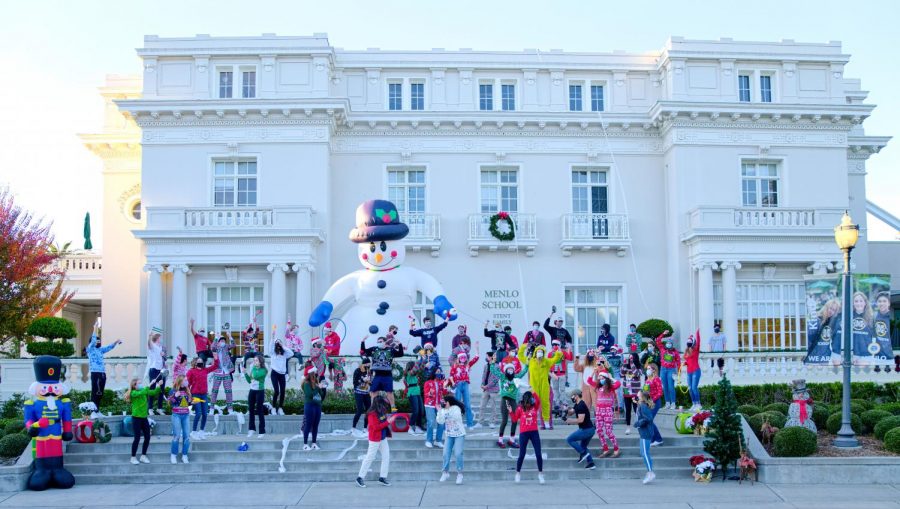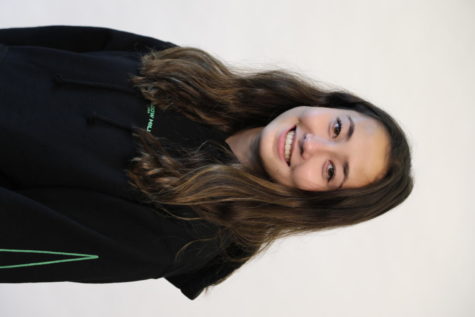Menlo’s Holiday Video: Behind the Scenes
Seniors gather at Menlo to film their section of the “Twelve Days of Christmas” song while remaining socially distanced. Unlike previous years, the song could not be performed at the annual holiday assembly because of COVID-19. Photo courtesy of Cyrus Lowe.
January 11, 2021
Every December, Menlo students look forward to the famous all-school holiday assembly. However, due to the COVID-19 school closure, the 2020 holiday assembly was canceled. Instead, a 50 minute video was emailed to faculty, students and their families on Dec. 17 to spread holiday spirit and to showcase the new Spieker Center for the Arts. The Spieker Center replaces Florence Moore Auditorium as Menlo’s theater for the performing arts.
The holiday video starts with a short speech delivered by Head of School Than Healy; after Healy’s speech, a group of students are featured on campus rehearsing and performing various tasks inside the Spieker Center. In order to produce this section of the holiday video, all participants were required to wear masks, pass frequent temperature checks and follow many other safety precautions, according to Video Producer Yohahn Ko. These regulations caused several filming setbacks. “There were people who[m] we initially wanted as talents to act in the video, but they couldn’t because they didn’t have a negative COVID test,” Ko said. “That provoked us to make last-minute casting choices.”
To make the recording process easier, the Spieker Center performance was filmed in separate takes rather than one long, continuous shot. According to sophomore Maya Debnath, the student actors spent four consecutive days working at Menlo to complete these different shots. “We would practice a scene for around half an hour before actually filming it,” Debnath said. “We usually did two or three scenes a day, and there were around ten or twelve of them in the video.”
Although the majority of the holiday video footage was filmed virtually, the Spieker Center section was not the only in-person footage. The dance enrichment program was also able to film an on-campus performance. Unlike the Spieker Center performance, the dance program incorporated both in-person and virtual dancers. Virtual dancers participated online from their own homes, while in-person dancers met on campus to film a socially distanced performance. Adapting to this hybrid model made the production process more stressful and time-consuming for Upper School dance teacher Angela Curotto-Pierson. “I had to retrain my brain to prepare for this piece,” Curotto-Pierson said. “The process was different from creating choreography and placing students on stage.” According to Curotto-Pierson, preparing students to dance in a video format was a very different experience from when she normally prepares them for a live audience.
Due to the lag on Zoom, virtual dancers appeared out of sync when attempting to dance together, according to sophomore Michele Hratko. As a result, they ended up having to film multiple takes of the dance individually. “We had to re-record and make changes several times,” Hratko said. “It was challenging to get the timing right and keep the same energy you’d usually have when performing on stage with actual people.”
Similarly to Hratko, seventh grader Noelle Lawson’s Mixed Chorus class also struggled to record over Zoom. Lawson’s class contributed a song to the holiday video, and the entire performance was recorded during a Zoom meeting. “We couldn’t sing because of all the delays,” Lawson said. To fix this, singers recorded themselves singing the song by themselves. These audio clips were then placed over a recording of the entire group lip-syncing together over Zoom.
Every year, it is Menlo tradition to sing “The Twelve Days of Christmas” song during the holiday assembly. The twelve lines are divided up equally between different grades and faculty groups. In order to preserve this tradition in the holiday video, students, faculty and their families were prompted to provide recordings of them singing their assigned line. However, seniors were allowed to gather socially distanced on campus and film their line, “five golden rings,” together. These clips of students and teachers singing were then combined to create a compilation for the holiday video.
Once all filming for the holiday video was completed, the next step was editing. Upper School dance teacher Bibi Khalili noted that it was important to provide students with equal time on screen. This was especially difficult when editing the dance portion of the video because of the mixture of in-person and virtual dancers. “I spent at least twenty to thirty hours editing different dance clips,” Khalili said.
Ko edited the vast majority of the holiday video. “The holiday video took two weeks of editing for an hour of content,” Ko said. He believes that the overall process might have been slightly less hectic if more time was dedicated toward preparations, especially since more unexpected issues are likely to occur when organizing performances virtually. “I wish there had been more pre-production and time to conceptualize how we could make the videos feel more cohesive,” Ko said.



